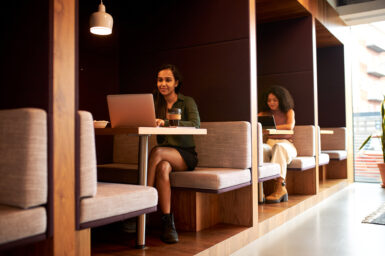Why Future-proofing
Our Workspaces is Vital
Why Future–proofing Our Workspaces is Vital

Traditional office spaces are facing a reckoning. The sector, for years underpinned by towering city-centre beacons, must now adapt to navigate the difficult times ahead – but there is hope, and rewards to be had, for landlords who are fast to respond to new working practices and demands.
Our new working life
There is no denying it, the way we work has changed. Remote and hybrid models look here to stay and have caused occupancy to reach new lows – and demand for shorter leases to increase, with uncertainty from occupants who might not know what their requirements will look like in the future. Apart from workers embracing a new work/life balance, high inflation has also meant increased costs for commuters, dissuading them further from forgoing working from home, or increasing time in the office, when hybrid models have been embraced.
Making things even tougher for the sector are rising interest rates, and for highly leveraged portfolios loan repayment hikes can simply become unmanageable, which has led to devaluations across the market.
Even with this landscape there is still hope for traditional offices, and for those who can future-proof themselves to align with the working world of today – and tomorrow – the outlook might not look so gloomy.
Is the future all about being flexible?
The answer for many at the current time is flexibility. Savills 2022 Landlord Flexible Office Survey showed 72% of landlords expect tenants to require more flexible lease terms, and cited a number of flexible landlords who have embraced this trend and are expecting strong growth – some doubling their portfolio in the coming years.
Separately, The Instant Group’s recent research shows flexible workspace occupancy at a record high of 83% across the UK. It is imperative that building owners evolve to meet this demand – both in terms of leases and spaces. However, it’s not only flexibility that will help landlords to future-proof their assets. Tenants are requiring a new kind of workplace, one that marries the social with working life, and locations and buildings that allow those who come to them to easily live, work and play.
What landlords can do
- The “15-minute city” & mixed-use buildings and environments
For some the uncomfortable daily commute has become a distant memory, and persuading those people to return to the office on a more regular basis can be hard. Fast and easy access to buildings is key, as are environments and locations that offer attractive public spaces, dynamic social outlets and homes that people want to live in. Concepts like the 15-minute city may not be new (renowned urbanist Jane Jacobs had them in her sights in the early 1960s), but post-pandemic this model marries most with what contemporary life might look like. - Environmental concerns
As environmental concerns become ever more pressing, building owners must also face up to the need to find solutions that will lower carbon emissions. Portfolios that are retrofitted are often seen as more favourable than new builds with their substantial environmental impact.
The time is now
It is clear that office portfolios must be primed for both our evolved working lives and contemporary concerns to perform well. Landlords who are ahead of the curve can surely only benefit from responding to what the working landscape will look like, with workspaces that blend convenience, flexibility and accessibility, and address environmental concerns at the same time. We’ve seen working life change fast over just 3 years, so landlords must have the agility, ability and desire to adapt to make the most of their assets.
Published: September 14 2023
Author: Ricardo Gato
